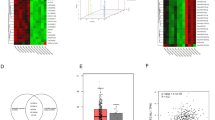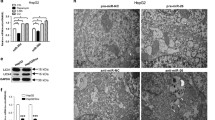Abstract
Purpose
In this study, we investigated the regulation of linc-ROR on autophagy and gemcitabine resistance of pancreatic cancer cells and further studied the underlying involvement of the miR-124/PTBP1/PKM2 axis in this regulation.
Methods
Pancreatic cancer cell lines PANC-1 and MIAPaCa-2 cells were used as in vitro model. Autophagy was assessed by western blot of LC3 I/II and observation GFP-LC3 puncta. Cell viability was examined using CCK-8 assay. Cell apoptosis was examined by flow cytometric analysis of Annexin V/PI staining. QRT-PCR, RNA fluorescence in situ hybridization and dual luciferase assay were used to study the expression and the binding between linc-ROR and miR-124.
Results
Linc-ROR siRNA significantly sensitized PANC-1 and MIAPaCa-2 cells to gemcitabine, while linc-ROR overexpression significantly reduced the sensitivity. Linc-ROR knockdown reduced basal autophagy, while linc-ROR overexpression markedly increased basal autophagy in the cells. Linc-ROR siRNA showed similar effect as 3-MA on enhancing gemcitabine-induced cell apoptosis and also reduced PKM2 expression. MiR-124 overexpression restored PKM1 and reduced PKM2 levels in the cells. In addition, miR-124 mimics also alleviated autophagy in pancreatic cancer cells. Both miR-124 mimics and PKM2 siRNA enhanced gemcitabine-induced cell apoptosis. In both pancreatic cell lines and PADC tissues, linc-ROR is negatively correlated with miR-124 expression. In addition, dual luciferase assay verified two 8mer binding sites between miR-124 and linc-ROR.
Conclusion
Linc-ROR confers gemcitabine resistance to pancreatic cancer cells at least partly via inducing autophagy. There is a linc-ROR/miR-124/PTBP1/PKM2 axis involved in regulation of gemcitabine resistance in pancreatic cancer cells.




Similar content being viewed by others
Change history
18 October 2021
This article has been retracted. Please see the Retraction Notice for more detail: https://doi.org/10.1007/s00280-021-04364-5
References
Siegel R, Ma J, Zou Z, Jemal A (2014) Cancer statistics, 2014. CA Cancer J Clin 64(1):9–29. doi:10.3322/caac.21208
Kleger A, Perkhofer L, Seufferlein T (2014) Smarter drugs emerging in pancreatic cancer therapy. Ann Oncol 25(7):1260–1270. doi:10.1093/annonc/mdu013
Singh S, Chitkara D, Kumar V, Behrman SW, Mahato RI (2013) miRNA profiling in pancreatic cancer and restoration of chemosensitivity. Cancer Lett 334(2):211–220. doi:10.1016/j.canlet.2012.10.008
Papademetrio DL, Cavaliere V, Simunovich T, Costantino S, Campos MD, Lombardo T, Kaiser CM, Alvarez E (2014) Interplay between autophagy and apoptosis in pancreatic tumors in response to gemcitabine. Target Oncol 9(2):123–134. doi:10.1007/s11523-013-0278-5
Song B, Bian Q, Zhang YJ, Shao CH, Li G, Liu AA, Jing W, Liu R, Zhou YQ, Jin G, Hu XG (2015) Downregulation of ASPP2 in pancreatic cancer cells contributes to increased resistance to gemcitabine through autophagy activation. Mol Cancer 14:177. doi:10.1186/s12943-015-0447-5
Yang MC, Wang HC, Hou YC, Tung HL, Chiu TJ, Shan YS (2015) Blockade of autophagy reduces pancreatic cancer stem cell activity and potentiates the tumoricidal effect of gemcitabine. Mol Cancer 14:179. doi:10.1186/s12943-015-0449-3
Ying L, Huang Y, Chen H, Wang Y, Xia L, Chen Y, Liu Y, Qiu F (2013) Downregulated MEG3 activates autophagy and increases cell proliferation in bladder cancer. Mol BioSyst 9(3):407–411. doi:10.1039/c2mb25386k
Liu Z, Wei X, Zhang A, Li C, Bai J, Dong J (2016) Long non-coding RNA HNF1A-AS1 functioned as an oncogene and autophagy promoter in hepatocellular carcinoma through sponging hsa-miR-30b-5p. Biochem Biophys Res Commun 473(4):1268–1275. doi:10.1016/j.bbrc.2016.04.054
Li L, Chen H, Gao Y, Wang YW, Zhang GQ, Pan SH, Ji L, Kong R, Wang G, Jia YH, Bai XW, Sun B (2016) Long noncoding RNA MALAT1 promotes aggressive pancreatic cancer proliferation and metastasis via the stimulation of autophagy. Mol Cancer Ther. doi:10.1158/1535-7163.MCT-16-0008
Loewer S, Cabili MN, Guttman M, Loh YH, Thomas K, Park IH, Garber M, Curran M, Onder T, Agarwal S, Manos PD, Datta S, Lander ES, Schlaeger TM, Daley GQ, Rinn JL (2010) Large intergenic non-coding RNA-RoR modulates reprogramming of human induced pluripotent stem cells. Nat Genet 42(12):1113–1117. doi:10.1038/ng.710
Zhan HX, Wang Y, Li C, Xu JW, Zhou B, Zhu JK, Han HF, Wang L, Wang YS, Hu SY (2016) LincRNA-ROR promotes invasion, metastasis and tumor growth in pancreatic cancer through activating ZEB1 pathway. Cancer Lett 374(2):261–271. doi:10.1016/j.canlet.2016.02.018
Gao S, Wang P, Hua Y, Xi H, Meng Z, Liu T, Chen Z, Liu L (2016) ROR functions as a ceRNA to regulate Nanog expression by sponging miR-145 and predicts poor prognosis in pancreatic cancer. Oncotarget 7(2):1608–1618. doi:10.18632/oncotarget.6450
Wang P, Chen L, Zhang J, Chen H, Fan J, Wang K, Luo J, Chen Z, Meng Z, Liu L (2014) Methylation-mediated silencing of the miR-124 genes facilitates pancreatic cancer progression and metastasis by targeting Rac1. Oncogene 33(4):514–524. doi:10.1038/onc.2012.598
Wang H, Ye Y, Zhu Z, Mo L, Lin C, Wang Q, Wang H, Gong X, He X, Lu G, Lu F, Zhang S (2016) MiR-124 regulates apoptosis and autophagy process in MPTP model of Parkinson’s disease by targeting to bim. Brain Pathol 26(2):167–176. doi:10.1111/bpa.12267
Gu H, Liu M, Ding C, Wang X, Wang R, Wu X, Fan R (2016) Hypoxia-responsive miR-124 and miR-144 reduce hypoxia-induced autophagy and enhance radiosensitivity of prostate cancer cells via suppressing PIM1. Cancer Med 5(6):1174–1182. doi:10.1002/cam4.664
Taniguchi K, Sugito N, Kumazaki M, Shinohara H, Yamada N, Nakagawa Y, Ito Y, Otsuki Y, Uno B, Uchiyama K, Akao Y (2015) MicroRNA-124 inhibits cancer cell growth through PTB1/PKM1/PKM2 feedback cascade in colorectal cancer. Cancer Lett 363(1):17–27. doi:10.1016/j.canlet.2015.03.026
Li C, Zhao Z, Zhou Z, Liu R (2016) PKM2 promotes cell survival and invasion under metabolic stress by enhancing warburg effect in pancreatic ductal adenocarcinoma. Dig Dis Sci 61(3):767–773. doi:10.1007/s10620-015-3931-2
Wang RC, Wei Y, An Z, Zou Z, Xiao G, Bhagat G, White M, Reichelt J, Levine B (2012) Akt-mediated regulation of autophagy and tumorigenesis through Beclin 1 phosphorylation. Science 338(6109):956–959. doi:10.1126/science.1225967
Gupta A, Mo YY (2011) Detection of microRNAs in cultured cells and paraffin-embedded tissue specimens by in situ hybridization. Methods Mol Biol 676:73–83. doi:10.1007/978-1-60761-863-8_6
Calabretta S, Bielli P, Passacantilli I, Pilozzi E, Fendrich V, Capurso G, Fave GD, Sette C (2016) Modulation of PKM alternative splicing by PTBP1 promotes gemcitabine resistance in pancreatic cancer cells. Oncogene 35(16):2031–2039. doi:10.1038/onc.2015.270
Hou P, Zhao Y, Li Z, Yao R, Ma M, Gao Y, Zhao L, Zhang Y, Huang B, Lu J (2014) LincRNA-ROR induces epithelial-to-mesenchymal transition and contributes to breast cancer tumorigenesis and metastasis. Cell Death Dis 5:e1287. doi:10.1038/cddis.2014.249
Zhou X, Gao Q, Wang J, Zhang X, Liu K, Duan Z (2014) Linc-RNA-RoR acts as a “sponge” against mediation of the differentiation of endometrial cancer stem cells by microRNA-145. Gynecol Oncol 133(2):333–339. doi:10.1016/j.ygyno.2014.02.033
Li L, Gu M, Bo Y, Shi S, Shan Y, Bao L, Yiwen Y (2016) Long non-coding RNA ROR promotes proliferation, migration and chemoresistance of nasopharyngeal carcinoma. Cancer Sci. doi:10.1111/cas.12989
Author information
Authors and Affiliations
Corresponding author
About this article
Cite this article
Li, C., Zhao, Z., Zhou, Z. et al. RETRACTED ARTICLE: Linc-ROR confers gemcitabine resistance to pancreatic cancer cells via inducing autophagy and modulating the miR-124/PTBP1/PKM2 axis. Cancer Chemother Pharmacol 78, 1199–1207 (2016). https://doi.org/10.1007/s00280-016-3178-4
Received:
Accepted:
Published:
Issue Date:
DOI: https://doi.org/10.1007/s00280-016-3178-4




